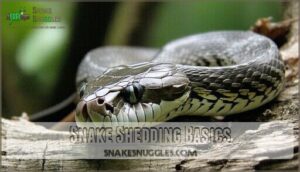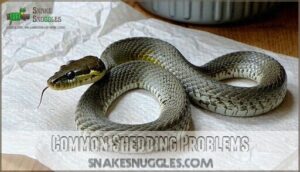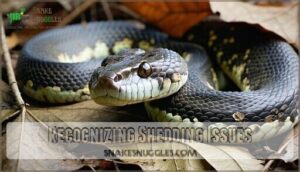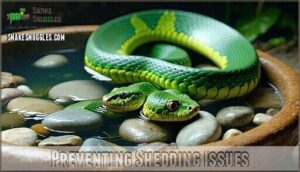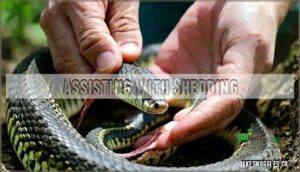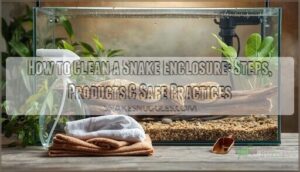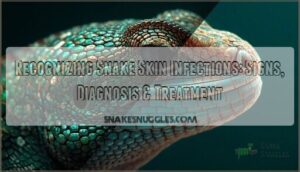This site is supported by our readers. We may earn a commission, at no cost to you, if you purchase through links.
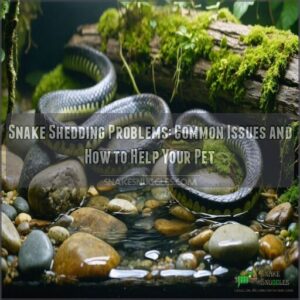
If your snake’s skin isn’t peeling cleanly, think of it as a hint that their environment needs tweaking. Verify their enclosure has proper humidity (usually 50-70%, but check your species’ needs) and offer rough surfaces, like a log, to help the process.
A warm soak or humidity hide can work wonders for stubborn patches. Stay vigilant—retained sheds can constrict circulation or impair vision.
Catching issues early saves headaches for you and keeps your snake healthy. Stay curious—there’s more to uncover, especially about proper humidity.
Table Of Contents
- Key Takeaways
- Snake Shedding Basics
- Common Shedding Problems
- Recognizing Shedding Issues
- Preventing Shedding Issues
- Assisting With Shedding
- Frequently Asked Questions (FAQs)
- What to do if your snake is having trouble shedding?
- Do snakes get stressed when shedding?
- Is it bad if my snake sheds in pieces?
- What are the symptoms of dysecdysis?
- Why does my snake shed a lot?
- What happens if a snake sheds its skin?
- Do snakes shed a lot?
- Is shedding a bad thing for a snake?
- Why shouldn’t you handle a shedding snake?
- What does it mean if your snake sheds in pieces?
- Conclusion
Key Takeaways
- Keep your snake’s enclosure at the right humidity (50-70%) and provide rough surfaces or a humidity hide to prevent incomplete sheds.
- Soak your snake in lukewarm water or use a damp cloth to help remove stuck skin, but don’t force it.
- Watch for signs of shedding trouble like retained eye caps, dull patches, or constrictions, and act quickly to avoid health risks.
- Regularly monitor your snake’s diet, hydration, and environment for smoother sheds and consult a reptile vet if issues persist.
Snake Shedding Basics
Shedding is a natural process that helps snakes grow and stay healthy, but it’s often misunderstood by pet owners.
Knowing how often your snake sheds and what a normal shed looks like can help you spot issues early.
Purpose of Shedding in Snakes
Shedding isn’t just a snake’s fashion statement—it’s essential for survival.
Shedding is a snake’s ultimate renewal, ensuring growth, health, and agility—it’s nature’s way of hitting the refresh button.
The snake shedding process renews its skin, enabling growth, repairing injuries, and ditching parasites.
This shedding cycle in snakes showcases evolutionary advantages, like maintaining agility and health. Think of it as a personalized tune-up for your pet—a key to healthy snake shedding and overall well-being.
Frequency of Shedding in Different Species
Different snake species shed at varying rates.
Ball pythons shed every 4-6 weeks, while corn snakes shed every 6-8 weeks.
Younger snakes cycle more frequently due to growth spurts.
Species shed rates also depend on diet, habitats, and seasonal variations.
Understanding the definition of ecdysis is essential for snake owners.
Addressing snake shedding problems starts with knowing your pet’s shedding frequency and monitoring their health and environment.
Normal Shedding Process and Timeline
As a snake grows, it periodically replaces old skin through the shedding process, or ecdysis.
This shedding cycle typically lasts 7 to 14 days, influenced by age, hormones, and health. During this time, skin layers loosen for removal, starting from the head.
- Key stages: skin dulls, eyes cloud, new skin forms.
- Shedding frequency: younger snakes shed more often.
- Humidity boosts speed: keep levels ideal.
Common Shedding Problems
Shedding problems in snakes, like incomplete sheds or retained eye caps, can lead to discomfort and health risks if not addressed.
Understanding the causes, from low humidity to underlying health issues, helps you step in and keep your pet healthy.
Incomplete Shedding (dysecdysis)
When your snake struggles with incomplete shedding, or dysecdysis, it’s often due to low humidity or health concerns.
Recognizing dysecdysis means noticing patches of retained shed, especially around the tail or body.
Preventing dysecdysis involves proper humidity, hydration, and a clean habitat.
For treatment, offer a soak or gentle help with shedding aids like a damp towel—it’s surprisingly effective!
Retained Eye Caps
Retained eye caps, or stuck eye scales, happen when shedding doesn’t go smoothly.
Dry air is the usual eye cap cause, but poor health or dehydration can play a part.
Treating spectacles safely means using a damp cloth or consulting a vet.
Preventing retention is best—boost humidity and hydration to protect their eyes and prevent corneal damage.
Don’t peel them!
Constricted Shedding Around Body Parts
Stuck shed snakes often face constricted shedding around body parts like tails and toes, which harms blood circulation and risks infection.
Toe constriction can lead to tail loss or scale damage if ignored.
Gently soak your snake, then massage the retained shed. Use a humidity hide and monitor closely—shedding problems, or dysecdysis snakes face, needs prompt attention to prevent further issues, including scale damage.
Environmental Factors Affecting Shedding
Humidity levels often make or break a snake’s shedding process.
Proper humidity creates shedding success; low levels lead to stubborn skin, while balance ensures your snake’s comfort and health.
Low humidity leads to dry, stubborn skin, while excess moisture invites mold—nobody wants that!
Balance is key.
Temperature gradients help snakes regulate their shed cycle, so spot-check with a thermometer.
Add a water dish for hydration and choose a substrate that holds adequate humidity.
Environmental factors? They’re everything—shed success starts here!
Maintaining proper humidity helps prevent common shedding issues, which is a critical aspect of snake care, ensuring a healthy shed cycle and preventing common problems, and it’s all about finding the right balance.
Health Issues Impacting Shedding
If your snake’s shedding isn’t smooth, an underlying health issue could be the culprit.
Skin infections, parasite infestations, and malnutrition effects all lead to snake shedding problems.
Injuries may also impact shedding, creating snake health concerns.
Always prioritize a veterinary consultation if reptile health issues persist—professional advice makes all the difference in addressing tough shedding challenges.
Recognizing Shedding Issues
When your snake has trouble shedding, you’ll notice key signs like stuck skin patches or cloudy eye caps that don’t clear up.
Spotting these issues early helps you take the right steps to keep your pet healthy and comfortable.
Visual Indicators of Shedding Difficulties
Spotting shedding symptoms isn’t tricky if you know what to watch for.
Keep an eye out for:
- Skin Patchiness: Pieces of retained skin clinging stubbornly.
- Opaque Eyes: A whitish eye cover failing to clear post-shed.
- Discoloration Signs: Dull or uneven skin tone persisting.
- Swelling Indicators: Lesion appearance at affected areas.
Monitoring these signs helps you catch shedding issues early.
Behavioral Changes During Problematic Shedding
When shedding problems arise, snakes may show appetite loss, increased hiding behavior, or irritability signs.
Activity reduction is common, and defensive postures might seem alarming but often reflect discomfort.
These shedding difficulties result from environmental or health-related factors.
Monitoring snake behavior during this time is vital for addressing shedding issues early—spot the signs, and you’ll help maintain your snake’s comfort.
| Behavior | Possible Cause | Action to Take |
|---|---|---|
| Appetite Loss | Shedding discomfort | Increase humidity, reduce handling |
| Hiding Behavior | Stress or illness | Provide a quiet, safe space |
| Irritability Signs | Frustration from stuck shed | Offer a humid hide or warm soak |
| Activity Reduction | Dehydration or weakness | Make certain access to fresh water |
| Defensive Postures | Discomfort or fear | Handle gently or avoid interaction |
Differentiating Normal Vs. Abnormal Shedding
Not all shedding is smooth sailing, but spotting snake shedding issues is simpler than you think.
Normal shedding involves a complete shed and smooth, vibrant skin, while abnormalities like dysecdysis can signal trouble.
Watch for:
- Shedding frequency shifts or retained skin patches.
- Skin appearance like dull patches or retained eye caps.
- Behavioral cues, such as constant rubbing or unusual hiding.
Maintaining proper humidity can prevent incomplete sheds.
Preventing Shedding Issues
You can prevent shedding problems by keeping your snake’s enclosure at the right humidity and temperature levels.
Don’t forget to provide shedding aids like rough surfaces and a good diet to keep their skin healthy.
Proper Enclosure Humidity Management
Maintaining the right humidity for shedding keeps your snake at ease.
Calibrate your hygrometer regularly to guarantee accuracy.
Adjust misting frequency based on your snake’s needs, and choose substrates that retain moisture without overdoing it.
Enclosure size and ventilation affect humidity control, so strike a balance.
Proper humidity aids in healthy shedding.
Add a humidity hide to offer a cozy spot for easier shedding.
Optimal Temperature and Lighting Conditions
Creating the right temperature and lighting keeps your snake healthy and shedding smoothly.
Follow these steps:
- Set a basking spot temp that matches your snake’s needs.
- Use a UVB lamp spectrum for daylight hours.
- Allow a nighttime temperature drop—reptiles need rest, too!
- Place a thermostat to monitor the temperature gradient precisely.
Balance is everything! To achieve this, remember that temperature control is crucial for your snake’s well-being.
Providing Appropriate Shedding Aids
A well-equipped enclosure helps tackle snake shedding problems. Add rough surfaces, like bark or rocks, to aid Safe Removal.
Use a Humidity Hide for consistent moisture, especially during shedding. Maintaining proper humidity levels is essential for successful shedding.
Misting Techniques and warm water soaks can loosen stubborn skin.
Check out the table below for quick pointers:
| Aid | Usage | Benefit | Caution |
|---|---|---|---|
| Humidity Hide | Daily use | Maintains moisture | Avoid mold growth |
| Misting Techniques | Twice daily | Loosens skin | Don’t oversaturate |
| Warm Water Soak | 15-20 min sessions | Hydrates skin | Check water temperature |
| Rough Surfaces | Enclosure-friendly | Eases shedding | Prevent sharp edges |
The key to successful shedding is maintaining the right environment, including proper humidity levels and using the right aids like Misting Techniques and Warm Water Soak to help loosen the skin, making the shedding process smoother.
Nutritional Considerations for Healthy Shedding
Boost your snake’s shedding success with better nutrition.
A well-rounded diet rich in vitamins, like Vitamin A for moisture, and minerals such as calcium, supports healthy skin.
Proper hydration is critical—fresh water and soaking options help softening.
Monitor feeding frequency to prevent malnutrition or overfeeding.
Balanced diet composition guarantees the best shedding and keeps pesky issues, like retained skin, at bay!
Regular Health Monitoring and Veterinary Check-ups
Regular check-ups with a reptile veterinarian are essential for snake health.
Early detection of issues like parasites or husbandry impact can save a lot of trouble later. Prioritize preventative care to keep problems in check.
- Schedule veterinary care annually.
- Screen for parasites during vet visits.
- Track shedding patterns for abnormalities.
- Monitor weight and overall snake health.
- Consult a reptile veterinarian for persistent issues.
Assisting With Shedding
Helping your snake shed properly keeps them comfortable and avoids health problems. With the right techniques, you can safely assist when nature needs a little nudge.
Safe Soaking Techniques for Snakes
A warm soak can work wonders for snake shedding problems.
Use lukewarm water (around 85°F), just deep enough to touch their belly.
Keep soak duration to 15-30 minutes, monitoring your snake handling gently.
For ideal comfort, consider a proper soaking container.
Avoid additives unless vet-approved for safety.
Post-soak care is key—gently pat them dry with a wet towel, boosting skin removal and maintaining humidity.
Gentle Manual Removal of Stuck Shed
If soaking didn’t fully remove the retained shed snake skin, gentle manual removal might help.
Use cotton swabs or wet towel technique to loosen stubborn areas, and apply safe lubricant options like mineral oil.
For small patches, tweezers or forceps—with steady hands—work well, but avoid scalpel use unless professionally trained.
Afterward, focus on post-removal care to prevent irritation or infection.
Creating a Humidity Hide Box
Creating a humidity hide box is a clever DIY solution for snake shedding problems.
Choose materials like plastic tubs or sturdy containers—size matters, so make certain it’s snug but not cramped.
Fill with damp sphagnum moss, maintaining adequate humidity levels.
This helps with shedding while keeping your snake comfortable.
You can even purchase a pre-made hide for convenience.
Regular maintenance tips? Replace moss often to avoid mold or unwanted smells.
When and How to Assist With Eye Caps
A humidity hide helps with stuck skin, but retained eye caps need extra care. Try eye cap soaking with warm water for 20 minutes to loosen them. Use safe removal tools like moist Q-tips or dabs of mineral oil to gently assist.
Avoid forceful eye cap removal—always prioritize your snake’s comfort.
- Don’t peel stubborn caps manually.
- Use proper lubrication during eye cap removal.
- Prevent eye caps with correct humidity levels.
- Seek veterinary assistance if issues persist.
Seeking Professional Veterinary Care for Complications
If stuck eye caps or other shedding issues persist despite your efforts, it’s time for veterinary assistance. A reptile veterinarian consultation identifies underlying medical problems like infections or blindness.
They may prescribe medication options or recommend surgical intervention for severe complications. Long-term care guidance guarantees shedding improves.
Don’t risk extensive procedures without a vet’s help—your snake’s health depends on expert care.
| Problem | Possible Cause | Treatment | Vet Expertise Needed? |
|---|---|---|---|
| Retained Eye Caps | Low Humidity | Increase Humidity | Often Yes |
| Stuck Skin Patches | Malnutrition | Improve Diet | Sometimes |
| Unresponsive Issues | Infection Signs | Medications | Yes |
| Severe Skin Damage | Underlying Medical Problem | Surgical Intervention | Yes |
Frequently Asked Questions (FAQs)
What to do if your snake is having trouble shedding?
Ever feel like your snake’s skin won’t let go?
Boost humidity to 70-80%, add a humid hide, or try warm water soaks.
Provide rough surfaces like rocks and always make certain of proper hydration.
Do snakes get stressed when shedding?
Absolutely, snakes can feel stressed while shedding.
It’s like wearing a too-tight sweater you can’t shake off.
Reduced handling, humidity boosts, and a cozy, damp hide can help them shed and relax more easily.
Is it bad if my snake sheds in pieces?
Think of shedding like unzipping a jacket—if it’s in pieces, it’s a sign your snake’s environment might need tweaks.
Check humidity, add a moist hide, and make certain proper hydration for smoother, healthy sheds.
What are the symptoms of dysecdysis?
Dysecdysis symptoms include retained skin patches, dull or incomplete shedding, constriction around body parts, and stuck eye caps.
You might notice decreased activity, appetite loss, or irritability.
It’s a sign your reptile needs help with proper shedding, which can be indicated by irritability.
Why does my snake shed a lot?
Your snake might shed often due to rapid growth, a high-protein diet, or health stressors like skin injuries or parasites.
Make certain its humidity, temperature, and nutrition are ideal to support healthy shedding, with healthy shedding being the key goal.
What happens if a snake sheds its skin?
Losing its skin is your snake’s version of a wardrobe upgrade—it keeps growing, so shedding clears out old layers.
This process allows healthy new skin to emerge, improving movement, sensory functions, and overall health.
Do snakes shed a lot?
Yes, they do!
Snakes shed regularly throughout their lives as they grow or repair skin.
On average, it’s every few weeks to months, depending on their size, age, species, and environmental conditions, with regularly being a key aspect of their growth.
Is shedding a bad thing for a snake?
Shedding is like hitting the refresh button—it’s a natural, healthy process for snakes.
It helps them grow and renew their skin.
However, trouble shedding signals issues, so monitoring and proper care are essential.
Why shouldn’t you handle a shedding snake?
Handling a shedding snake stresses it out and can harm its delicate new skin.
It’s like interrupting someone mid-shampoo—uncomfortable and unnecessary.
Give your snake space to shed smoothly and naturally.
What does it mean if your snake sheds in pieces?
It’s like your snake’s shedding turned into a puzzle—only not a fun one.
Shedding in pieces usually means low humidity or poor hydration, making the process tough.
Boost humidity, add a humid hide, and monitor.
Conclusion
Did you know snakes can shed up to 12 times a year, depending on their age and species?
Shedding issues, like incomplete sheds or retained eye caps, often signal gaps in humidity, hydration, or overall care.
By keeping the enclosure’s humidity in the ideal range, providing shedding aids, and acting quickly on any stuck patches, you’ll help prevent snake shedding problems.
A little attention to their environment goes a long way in keeping your snake healthy and stress-free.

